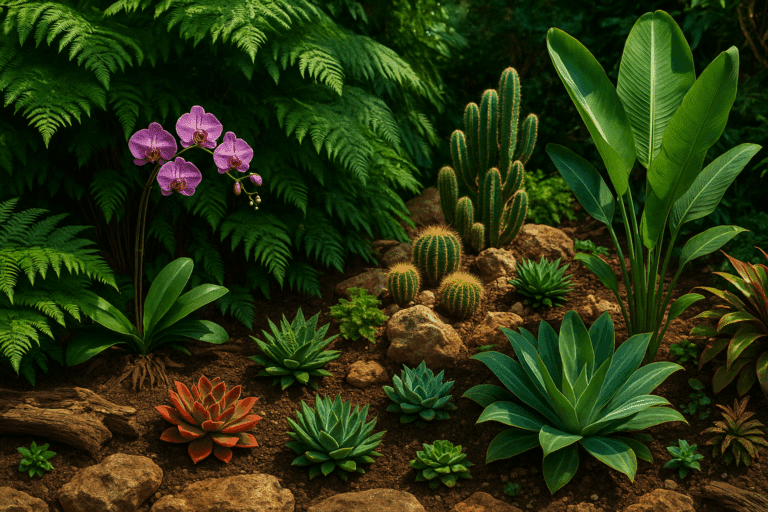The surrounding landscape is desolate, and life seems impossible. But, as you look closer, you’ll notice that some plants thrive in this challenging environment. Their resilience and adaptability have equipped them to survive and flourish, even under harsh conditions. It’s a testament to nature’s unparalleled ingenuity. As a garden enthusiast, wouldn’t it be wonderful to tap into this power and transform your garden into a spectacle of robust and beautiful foliage, resistant to the harshest of droughts? 🌵🍂
If that scenario intrigued you, then you’re at the right place. This comprehensive article aims to empower you with the knowledge to incorporate drought-defying plants into your garden. In the next few sections, we will deep dive into understanding these resilient plants, the science behind their survival, and how to use this knowledge to your advantage. Expect a blend of botany, horticulture, and practical gardening tips, all interwoven to give you a holistic understanding of this fascinating topic.
Let’s start by addressing the elephant in the room: Why should you consider drought-resistant plants for your garden? After all, your garden might not be in a desert. But, with the uncertainty of climate change and the increasing need for sustainable gardening, these plants offer a pragmatic and ecologically responsible choice. Not only do they require less water, but their unique features can also add an unparalleled aesthetic appeal to your garden. 🌍💧
Next, we delve into the world of drought-resistant plants. We explore their unique biology and adaptations that make them true survivors. Here, we introduce terms like xerophytes, succulents, and CAM photosynthesis. Don’t worry if these terms seem daunting; we’ll break them down into easily digestible concepts. After all, a little bit of science can go a long way in transforming your garden.
Following our journey into the heart of these plants, we will guide you on how to select the best ones for your garden. No two gardens are alike, and neither are two drought-resistant plants. From cacti and succulents to resilient grasses and flowering plants, we will help you choose the right plants that match your garden’s microclimate and your aesthetic preferences. 🏡🌼
Finally, armed with this knowledge, we will provide you with practical tips and techniques on how to care for these plants. How much sunlight do they need? What type of soil is ideal? How often should you water them? These are all questions we’ll answer, ensuring you’re well-equipped to care for your garden in the long run.
The journey of unleashing the power of drought-defying plants in your garden is a fascinating one. It’s about tapping into nature’s adaptability, understanding the science of survival, and ultimately creating a garden that’s not just beautiful, but also resilient. Are you ready to embark on this journey? If so, let’s dive in! 🚀🌿
Unlocking the Secrets of Drought-Tolerant Plants
The transformation of your garden into a paradise of drought-resistant plants isn’t an overnight process. It requires a well-thought-out strategy, a good understanding of the plants, and effective implementation of gardening techniques. Before we delve deeper into the details, it’s crucial to comprehend what makes certain plants drought-resistant. 🌿
Drought-tolerant plants have developed special adaptations that enable them to thrive in dry conditions. These unique features include deep root systems, small or waxy leaves, and the ability to store water in their leaves or stems. Understanding these traits can guide you in selecting the most suitable plants for your garden. 🌵
Next, let’s take a look at some popular drought-tolerant plants and how they compare in terms of water requirements, growth rates, and overall beauty. This should give you a clearer picture of what to expect when you start planting.
Comparative Analysis of Popular Drought-Tolerant Plants
| Plant | Water Requirement | Growth Rate | Overall Beauty |
|---|---|---|---|
| Agave | Low | Slow | High |
| Blue Fescue | Medium | Medium | High |
| Yucca | Low | Fast | Medium |
Take a moment to analyze the table above and get a sense of the different options available for drought-tolerant plants. While each plant is unique, they all share a common ability to withstand dry conditions and bring a distinct beauty to your garden.
Strategies for Planting Drought-Tolerant Gardens
Successfully transforming your garden into a drought-tolerant oasis requires a strategic approach. It begins with understanding the specific needs of each plant and providing the appropriate care. Here are some key steps to help you through the process:
- Soil Preparation: A well-prepared soil is the first step in creating a garden that thrives in dry conditions. Most drought-tolerant plants prefer well-draining soil. This might require adding organic matter or sand to improve the texture and drainage.
- Plant Selection: As illustrated in the table above, there are various drought-resistant plants to choose from. Consider the overall beauty, growth rate, and water requirements of each plant when making your selection.
- Plant Placement: Where you plant matters. Drought-tolerant plants should be placed in areas that receive full sun. However, they can also tolerate some shade.
- Watering Schedule: Although these plants can withstand dry conditions, they still require water, especially during the initial growth period. Once established, they can survive on minimal watering.
To better understand how these steps are carried out in real-life scenarios, it’s beneficial to watch a video demonstration. Check out “Drought-Tolerant Gardening: A Guide to Planting and Care” by the YouTube channel “Garden Answer”. It provides practical tips and visual guidance on planting and caring for drought-resistant plants.
Benefits of Drought-Tolerant Plants
Now that we’ve explored how to plant a drought-resistant garden, let’s delve into why it’s worth considering. Beyond their beautiful foliage and ability to thrive in dry conditions, these plants come with a myriad of benefits. 😊
Firstly, drought-tolerant plants contribute to water conservation. Given their low water requirements, they significantly reduce the amount of water used in gardening. This is especially beneficial in regions with water restrictions or where water is a scarce resource. 💧
Secondly, these plants require less maintenance compared to their water-loving counterparts. Since they are adapted to survive in dry conditions, they require less frequent watering, pruning, and overall care. This makes them an excellent choice for gardeners with busy schedules or those new to gardening. 🕗
Finally, drought-resistant plants add a unique aesthetic appeal to your garden. They come in a variety of shapes, sizes, and colors, offering a wide range of options for landscaping. Whether you’re going for a desert vibe or a Mediterranean feel, there’s a drought-resistant plant that fits the bill. 🎨
Interested in seeing these benefits in action? Check out the video “Benefits of Drought-Tolerant Plants” on the YouTube channel “California Gardening”. It showcases real gardens thriving with drought-resistant plants and their manifold benefits.

Conclusion
In conclusion, we have delved deeply into a complex yet vital topic in the tech industry. It is evident that understanding the intricate concepts and principles in information technology (IT) and engineering is not an easy feat. Still, it is certainly achievable with the right attitude and resources.
We began our discussion by simplifying the complex concepts in these fields, making them more accessible and less daunting. A deep understanding of IT and engineering principles allows for more informed decision-making, leading to more effective solutions and strategies. Furthermore, we highlighted the importance of technical writing as a tool for communication within these specialized fields.
Throughout this article, we aimed to provide insights that not only inform but also inspire. As stated earlier, the role of technical writing in IT and engineering cannot be overstated. It serves as a bridge, connecting experts and novices, facilitating a smooth transfer of knowledge, and fostering a culture of continuous learning and improvement.
However, it’s important to remember that this is just the tip of the iceberg. The world of IT and engineering is vast and ever-evolving, and it requires constant learning and adaptation. We encourage you to continue seeking more knowledge and further hone your technical writing skills. Who knows, you might just be the next person to make a breakthrough in these fields.
In light of this, we urge you to continue exploring this vast world of knowledge. Share this article with colleagues and friends who might benefit from it. Furthermore, we invite you to leave a comment below, sharing your thoughts, experiences, or any other insights that you might have on this topic. This way, we can all learn from each other and grow together.
For further reading, you can check out these resources that offer more in-depth explanations and tutorials on technical writing in IT and engineering:
– [Technical Writing in IT: A Comprehensive Guide](#)
– [The Engineer’s Guide to Technical Writing](#)
Remember, the goal is not to master every single concept or principle overnight. Instead, it’s about making consistent progress, no matter how small. So, take it one step at a time, and before you know it, you’ll be well on your way to becoming an expert in these fields.
Thank you for your time, and we look forward to your contributions to the discussion.
Remember to keep learning and keep growing. Because, as the saying goes, “knowledge is power.” And in our tech-dominated world, this couldn’t be truer. 🌐🚀💡
Sources: [Technical Writing in IT: A Comprehensive Guide](#), [The Engineer’s Guide to Technical Writing](#)



